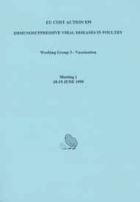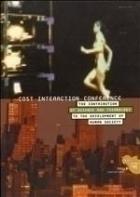
Behandlung von kläeschlamm

Graphical Interaction with Gridded Fields

Plant in Vitro - Culture Report 1992

Immunosuppressive Viral Diseases in Poultry - Working Group 3, Vaccination, Meeting 1, 18-19 June 1999

Performance Assessment of Urban Infrastructure Services: The Case of Water Supply, Wastewater and Solid Waste
- Pages: 146
- Author(s): F. Sjovold, P. Conroy, E. Algaard
- Publisher(s): SINTEF
- Download from external website
- ISBN/ISSN: 978-82-536-1010-6²
This report provides an overview of the findings of the COST Action C8. The main objective of the Action was to increase the knowledge and to promote the use of effective, scientifically robust and well divided methodologies for decision-making, based on the use of performance indicators for urban infrastructure services. Moreover, they encourage utilities to use them as routine management tools.

COST Interaction Conference
- Pages: 101
- Author(s): B. Reichert
- Publisher(s): OPOCE
- Download from external website
- ISBN/ISSN: 92-827-7020-6
- EUR: 16827
The Swiss authorities and European Commission jointly organised the COST Interaction Conference from 9 to 11 October 1995 in Basel (CH). More than 600 participants from inside and outside the COST networks attended this event. The conference was structured around 3 symposia:

OBS* Special Issue `Networked belonging and networks of Belonging´
- Publisher(s): OBS*
- http://obs.obercom.pt/index.php/obs/issue/view/34
- ISBN/ISSN: 1646-5954
This special issue results from the work of Working Group 2, Task Force 3 of the Cost Action IS0906 “Transforming Audiences, Transforming Societies”.

Proceedings of the Conference of COST Action FP1402 Graz University of Technology, Institute of Timber Engineering and Wood Technology Graz, Austria, 13.09.2017
- Author(s): Brandner, R., Ringhofer, A. & Dietsch, P. (Eds.)
- Download PDF
The objective of the joint conference was to record the current state-of-the-art for connections in timber engineering, and to illustrate how new developments will be adopted in the next generation of Timber Design Standards (e.g. Eurocode 5:2022). It was an opportunity to hear presentations from some of the world’s leading experts and to join discussions on the design, application and performance of Connections in Timber Engineering. There were presentations on current performance indicators, (e.g. strength, stiffness and ductile vs. brittle failure modes), as well as applications of connections in cross-laminated timber and timber-concrete composite structures. The Conference will also include presentations on current developments of design rules (e.g. for brittle failure modes, reinforcement and seismic design) and give an outlook on the potential of numerical modelling and probabilistic methods for future design of efficient and reliable connections.

Basic & Clinical - Pharmacology & Toxicology (Volume 96, N° 3, March 2005) - Action COST B15: "Modelling During Drug Development"
- Pages: 271 pages
- Author(s): K. Brosen
- Publisher(s): Nordic Pharmacological Society
- ISBN/ISSN: ISSN : 1742-7835 | 1742-7835
The main objective of the Action was to improve the predictive potential of scientific information gathered within the framework of development of new, efficacious and safe drugs, as well as sustainable industrial chemicals. Some form of modelling is performed during any of these “steps” have some contact with others, active in “neighbours steps”. However, as often demonstrated in practice, valuable information is not necessarily available for scientists active in “steps” that are further apart. For industrial chemicals, “empirically fixed safety factors” are presently used to scale up from animal data to humans.
This approach is not scientifically well based and does not take into consideration all information which is (or could be made) available. In this context, Action COST B15 provided a powerful tool to improve communication between scientists from Academia, the Industry and Governmental Entities.
